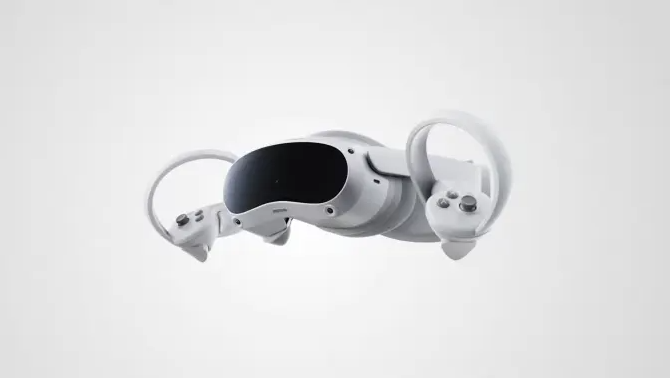ByteDance’s Pico 4 VR Headset Revealed
The Chinese VR hardware startup, Pico, which was acquired by TikTok parent company ByteDance last year, has now revealed its new virtual reality headset, the Pico 4 headset.
The Pico 4 is launching in Europe and a few countries in Asia and costs from €429 (which is roughly $429). Like the Meta Quest 2 headset, it is fully featured and affordable. Pico is looking to take on Meta in European and Asian markets with this product. It is a consumer-focused virtual reality headset targeting games and passive entertainment use cases. General pre-orders for the headset start in October and the headset begins shipping on October 18th.
ByteDance teased the news of the Pico 4 headset last week. The new device looks like the other Pico products. It is encased in a standalone and self-contained headset and can be connected to PC VR for a high-end virtual reality experience.
Imagination, the only limitation #PICO4
PICO 4 is well-equipped to provide an enhanced #VR experience without compromising comfort.
Let us know which features you love the most!
Click https://t.co/JNkeOROcNo to learn more! pic.twitter.com/ywu4gt8iRN
— PICO XR (@PICOXR) September 22, 2022
The Pico 4 headset is smaller and lighter than the previous Pico Neo 3 Link headset the company launched in May. The Pico headset weighs just 295 grams without the strap. With the strap, the headset weighs 586 grams.
The Pico 4 headset uses the Qualcomm Snapdragon XR2 chip, the same one in the Meta Quest 2 headset. However, it packs a RAM of 8GB compared to the 6GB RAM in the Quest 2. Its display also has a higher resolution of 2,160 x 2,160 pixels per eye.

Like the Quest 2 headset, the Pico 4 has two storage sizes: the 128GB model that costs EUR429 and the 256GB version that foes for EUR499 (roughly $429). Its battery gives you up to three hours of use. Like the previous Pico headset, the Pico 4 headset is built into the back strap of the headset for better balancing.
The Pico 4 headset isn’t launching in the US yet. Instead, the headset is launching in 13 countries in Europe and Japan, and South Korea.
Before the headset’s general preorder and retail release, the company is giving members of the Pico Neo3 Link beta program an advance preorder opportunity from September 23rd in the countries where it will launch in October.
On September 27th, Pico announces the headset for the Chinese market. Before the end of the year, the Pico 4 headset also launches in Malaysia and Singapore.
The fact that the headset is in the FCC regulatory filings shows that a US release could also be in the offing.
According to Pico EMEA general manager, Leland Hedges said the Pico 4 headset was the first virtual reality headset built for various new adopters and which is suited for a combination of fitness, gaming, and video applications.
Like the Pico Neo 3 Link, the Pico 4 enables you to play SteamVR games on a PC and the dedicated Pico app store.
Additionally, Pico has also lined up a new social environment known as ‘Pico Worlds’ that is set to launch in 2023.
The acquisition of Pico by ByteDance was also followed by a limited TikTok integration enabling users to optionally connect their TikTok account with the Pico video app that allows them to watch the TikTok videos in the VR headset.
ByteDance is looking to challenge Meta’s dominance of the VR consumer market, where the Meta Quest 2 currently enjoys wide popularity. The company tried that with the Pico Neo 3 Link but with the Pico 4, the company now offers comparable specs to the Quest 2 headsets and about the same price tag following Meta Quest’s recent $100 increase in July.
Pico is not new in this space; it has been building standalone virtual reality headsets longer than Meta. However, its updates such as a fitness center and Pico Worlds (a Meta Horizon counterpart) are similar to Quest’s features.
The Pico 4 headset also provides hand tracking functionalities just like the Quest 2 headset. Pico is also announcing the Pico 4 headset just a few weeks before Meta’s upcoming Connect 2022 event where the Project Cambria headset will be released.
The Pico 4 headset, however, doesn’t have the high specs and advanced features found in the Project Cambria headset. For instance, the Cambria (the Meta Quest Pro headset) features internal cameras for eye-tracking functionality.
Pico says it is targeting first-time consumers looking for ease of use, accessibility, and affordability in their VR headsets. Pico also says it was looking to keep the headset simple for its developer community, a good number of whom will be using a Pico headset for the first time. The company says the Pico 4 headset will be its main consumer product.
Later on, ByteDance is planning to release a costlier version of the headset in China known as the Pico 4 Pro which features eye-tracking cameras. In other markets, this ‘Pro’ headset will be sold as Pico 4 Enterprise. In this respect, Pico is following the format of previous headsets where eye-tracking is offered as an extra upgrade.
https://virtualrealitytimes.com/2022/09/22/bytedances-pico-4-vr-headset-revealed/https://virtualrealitytimes.com/wp-content/uploads/2022/09/Pico-4-Headset-600x317.pnghttps://virtualrealitytimes.com/wp-content/uploads/2022/09/Pico-4-Headset-150x90.pngBusinessHardwareVR HeadsetsThe Chinese VR hardware startup, Pico, which was acquired by TikTok parent company ByteDance last year, has now revealed its new virtual reality headset, the Pico 4 headset. The Pico 4 is launching in Europe and a few countries in Asia and costs from €429 (which is roughly $429). Like...Rob GrantRob Grant[email protected]AuthorVirtual Reality Times - Metaverse & VR
